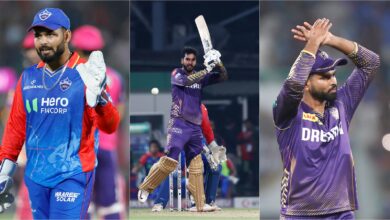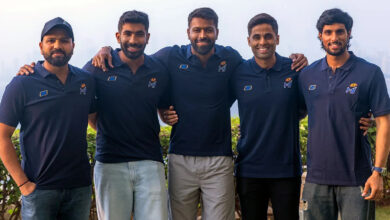Women’s T20 World Cup: Behind Australian cricket team’s might, an uncompromising fitness programme

The semifinal he against India that Australia skipper Meg Lanning described as ‘one of the best wins I’ve been involved in’ was won beyond the spectrum of just bat and ball.
While India captain Harmanpreet Kaur rued poor fielding at the end of the semifinal, her Australian counterpart would have no reason to point fingers at her teammates. The five runs that separated the two sides may as well have been thanks to some spectacular efforts in the deep. That Harmanpreet run out not only slowed things down for Australia but it also saved an extra run thanks to Beth Mooney’s precise throw and wicket keeper Alyysa Healy’s quick hands.
Two diving saves at the boundary line from Ellyse Perry that gave away only four runs instead of eight. Those three solo acts made a difference. A win that booked a seventh consecutive T20 World Cup final berth for Australia. A win that puts them just one win away from a fourth major title in four years.
Noel McCarthy is used to watching such moments of magnificence from close quarters thanks to his time with the team as former physical performance coach during the course of two World Cup wins (in 2020 and 2022).
“The team’s probably what you expect them to be,” he tells The Indian Express. “Every day they are looking to get better and don’t miss an opportunity in the practice session of doing so. The important thing is that high levels in physical performance has become non-negotiable to play for the national team.”
A match-winning save!
This Ellyse Perry moment could be featured in your @0xFanCraze Crictos Collectible packs!
Visit https://t.co/8TpUHbQikC to own iconic moments from the #T20WorldCup. pic.twitter.com/wajJQ5oMa0
— ICC (@ICC) February 23, 2023
McCarthy, who has also worked with Victoria women’s cricket team, credits the cricketing hierarchies in Australia for investing in women’s cricket earlier than most of their counterparts around the world. A move that is now bearing results.
“Cricket Australia have to be commended for the foresight and investment they put in the women’s game,” he says. “I felt very well supported and well resourced. And that’s not just with the national team but the state associations as well have made that effort to highlight the importance of the women’s game. I haven’t worked with the men’s team but I never felt second to them.”
Physical fitness has been an overarching theme of the ongoing T20 World Cup. Hosts South Africa had taken a call to drop star all-rounder Dane Van Niekerk ahead of the tournament after she failed to meet minimum fitness standards. The Proteas are now set to take on Australia in their first ever T20 World Cup final at Cape Town on Sunday.
While McCarthy does suggest that dropping a player solely on the basis of fitness may be counterproductive, he adds that in order to keep up with the pace of an evolving game, it is imperative to make fitness a priority.
“I think it’s important not to lose sight of the fact that as the game has evolved it has become clear that athleticism can bring advantage in terms of more powerful strokes, faster running between wickets, more bowling intensity, more effective fielding and the ability to be more durable in terms of injury prevention. All of these aspects either help create more scoring opportunities for your team or restrict scoring opportunities for the opposition. That being said, in cricket, athleticism is complementary to individual talent,” McCarthy says.
In cricket, what does athleticism mean though? “It could be viewed as a means to enhance/magnify talent. So I think in order to achieve better cricket performance, teams most certainly need to be chasing greater athletic standards as a point of difference over the opposition. This requires long term investment in a high performance environment that is supportive of the players achieving these standards. The goal should be to achieve the highest individual standards, not avoid the lowest. Over time high standards become the norm and players who haven’t worked at these standards, will likely be exposed on field and therefore would justifiably be excluded from selection.”
In contemporary times however, the aforementioned term can be maken with bulging muscles. There is an image of the modern day athlete. One that sells sport. McCarthy feels that image needs to be drawn cleanly if cricket has to thrive.“I’ve no doubt that the spectacle of play is what sells and will continue to sell matches, which is of course complemented athleticism. My opinion is that the game is continuing to gain popularity based on the cricket performance of the players. I couldn’t think of anything more destructive for the game than to place an emphasis on how the individuals look.”
More than meets the eye
The game’s image as a largely static one however is misinterpreted. While individual moments of brilliance in the field such as a catch, run out or a diving save are given their due, that’s not it.
Australia celebrate the wicket of India’s Richa Ghosh during the Women’s T20 World Cup semi final cricket match in Cape Town, South Africa, Thursday Feb. 23, 2023. AP/PTI(AP02_23_2023_000234B)
In 2021, playing the second of three ODIs against India, opener Beth Mooney was on the field for all of the 100 overs, covering 17.941 km across the duration of the game. Mooney scored a century to see off the last ball, five wicket win for Australia.
GPS data revealed that she accelerated at high intensity 216 times during what amounted to around 7.5 hours on the field.
Australia’s second-highest run scorer and their leading wicket taker in the game, Tahlia McGrath wasn’t far behind. She covered 17.057 km through the game, including an incredible 100 high intensity accelerations. The dance covered was much higher than what an average football player covers in a single game (9-10 km).
“That’s a long dance,” McCarthy says. “There’s also an endurance component to it and players can do that for one game. But to keep backing it up, that’s the challenge. And that’s why you’ve got to be conditioned enough. Explosive stuff is incredibly important to the performance but there’s also that endurance aspect.”
“All those things that you see on the television, kind of relate to explosiveness, power, reaction time and skill,” says McCarthy. “What you don’t see, is when the TV goes to the advertisement, you got to swap ends every time. There’s a lot of running and movement that isn’t actually in play. That’s why when I say, in the game where Mooney and McGrath covered 17 km, people are shocked that.”
When the world stopped
The year 2020 is a relevant flashback to help put into perspective the incredible numbers behind Mooney, McGrath, and this Australian team. The Covid-19 pandemic put a halt on cricket days after Australia were crowned T20 champions in front of a record crowd at the MCG.
For the then Australia physical performance coach, the task of keeping the champions stay fit was not easy.
“When it first happened, I actually met Meg (Lanning) in a park. We filmed a whole heap of drills with pads and stuff to send it to the players. But I think it was a bit of a running joke, some players did it but I think a lot of them probably threw their bands out. They had their own proper equipment at home. So once I realized that, I was able to still programs mostly as I normally would because the players would invest in that themselves.”
“I wouldn’t have to zoom (call), it would be typing their programs at the Athlete Management System (AMS) as I always would. It would come up on their phones and they did their training at home. Some states still had access to gyms. Victorians for example, the New South Wales players would have their home gym set up. You would have to go off yourself and do your running in the park but they did it and when we tested the players, there were a lot of personal bests gained. I mean it’s just phenomenal focus and professionalism to be able to do that.”
Similar perhaps to what they delivered in crunch moments of the semifinal on Thursday. Similar perhaps to what the other teams in the women’s game aspire to have.







